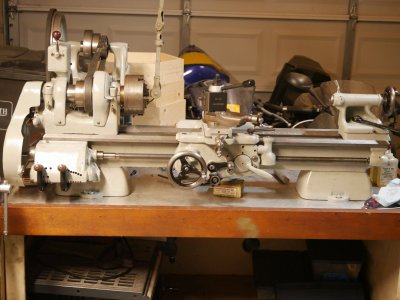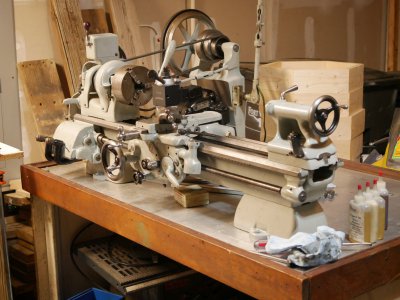- Joined
- Dec 30, 2022
- Messages
- 40
Hey all,
Recently acquired a 1947 SB 9A. The only other lathe I've owned is a Grizzly mini lathe so I am very new to this, apologies for beginner questions.
I purchased the ILION restoration book and kit, and in going through it I've taken everything apart and thoroughly cleaned, replaced wicks and oiled. Also painted because why not. Not quite finished in the following pics, but it will show the drive assembly which is the root of my question here.


The lathe runs and I'm happy with it at low speeds, but at higher speeds it seems to vibrate quite a lot. I'd like to start checking some things to see if I can reduce this.
Things I've checked:
I've seen in other threads people mention the run-out on the motor and counter-shaft, what would be considered normal/acceptable values for those? I can see in the current motor the bushings look pretty worn out, so I'd like to replace those. My lathe does not appear to have replaceable bronze bushings for the counter-shaft, so if that is worn do I just need to buy a new one (whatever that whole assembly the motor mounts to is called)?
What about belts? Can/should I replace with a link belt so I never accidentally put the spindle in without the belt wrapped around it??
Anything else you would check?
Any and all help appreciated.
Recently acquired a 1947 SB 9A. The only other lathe I've owned is a Grizzly mini lathe so I am very new to this, apologies for beginner questions.
I purchased the ILION restoration book and kit, and in going through it I've taken everything apart and thoroughly cleaned, replaced wicks and oiled. Also painted because why not. Not quite finished in the following pics, but it will show the drive assembly which is the root of my question here.


The lathe runs and I'm happy with it at low speeds, but at higher speeds it seems to vibrate quite a lot. I'd like to start checking some things to see if I can reduce this.
Things I've checked:
- Spindle runout is very minimal. I've adjusted the headstock bearing screws to get .001" deflection on the spindle pulling on a bar with 75 lbs of force (ok, didn't measure force exactly, but I did guesstimate)
- Squareness of belts/pulleys. As best as I can messure with a large carpenter square everything is aligned, the belts don't quickly wander to the side when I run things
I've seen in other threads people mention the run-out on the motor and counter-shaft, what would be considered normal/acceptable values for those? I can see in the current motor the bushings look pretty worn out, so I'd like to replace those. My lathe does not appear to have replaceable bronze bushings for the counter-shaft, so if that is worn do I just need to buy a new one (whatever that whole assembly the motor mounts to is called)?
What about belts? Can/should I replace with a link belt so I never accidentally put the spindle in without the belt wrapped around it??
Anything else you would check?
Any and all help appreciated.

